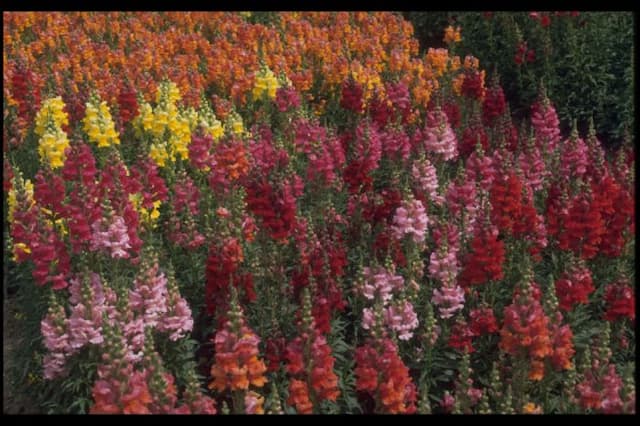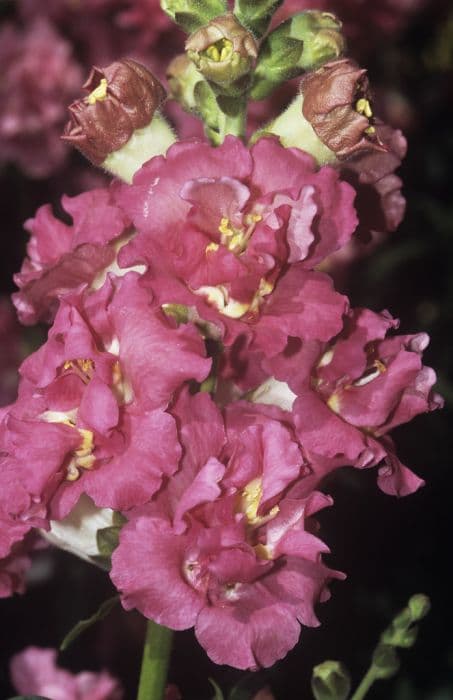Hebe Mohawk Hebe 'Mohawk' (PBR)

ABOUT
Hebe 'Mohawk' is a compact evergreen shrub that features glossy, dark green foliage. The leaves are spear-shaped with a slightly curved appearance and often have a leathery texture. This plant is known for its showy flower spikes, which consist of small, tubular blooms. The flowers typically present themselves in a white or pale lilac color, with some varieties showing off deeper shades of purple. These blooms have a tendency to attract butterflies and bees, adding to the visual interest of the plant. As the seasons change, the foliage may also take on a purplish tint, particularly in the cooler months, adding to the plant's ornamental appeal. Overall, Hebe 'Mohawk' presents a lush and vibrant appearance, with its combination of striking flowers and rich, green leaves.
About this plant
 Names
NamesSynonyms
Hebe 'Mohawk', Mohawk Hebe, Veronica 'Mohawk'
Common names
Hebe 'Mohawk' (PBR)
 Toxicity
ToxicityTo humans
The Hebe plant, commonly referred to by its genus name, is not generally considered toxic to humans. However, as with any plant, individual allergies or sensitivities could potentially exist. In general, if Hebe were to be ingested, it is unlikely to cause more than mild stomach upset. There are no commonly reported severe symptoms associated with the ingestion of the Hebe plant.
To pets
The Hebe plant is also not generally considered toxic to pets. It is not known to be a commonly toxic plant for dogs, cats, or other domestic animals. If a pet were to ingest part of a Hebe plant, they might experience mild gastrointestinal discomfort, but serious toxicity is unlikely. However, it’s always best to discourage pets from eating any ornamental plants due to individual sensitivities and the potential for unexpected reactions.
 Characteristics
CharacteristicsLife cycle
Perennials
Foliage type
Evergreen
Color of leaves
Green
Flower color
Purple
Height
3 feet (0.91 meters)
Spread
2 feet (0.61 meters)
Plant type
Shrub
Hardiness zones
8
Native area
New Zealand
Benefits
 General Benefits
General Benefits- Attracts pollinators such as bees and butterflies, which are essential for the pollination of plants and the overall health of local ecosystems.
- Low maintenance, as Hebe 'Mohawk' typically requires minimal care once established, making it ideal for gardeners of all skill levels.
- Drought-tolerant, making it suitable for planting in areas prone to dry spells or for gardeners seeking a water-wise landscape.
- Evergreen, providing year-round interest with its foliage even when not in bloom, which enhances the appeal of a garden in all seasons.
- Compact growth habit, which makes it suitable for small gardens, borders, and container planting where space might be limited.
- Hardy to various temperatures, capable of withstanding cooler climates and occasional frosts, broadening its suitability across different zones.
- Aesthetic appeal, with its attractive flowers and foliage that can add color and visual interest to various landscape designs.
 Medical Properties
Medical PropertiesThis plant is not used for medical purposes.
 Air-purifying Qualities
Air-purifying QualitiesThis plant is not specifically known for air purifying qualities.
 Other Uses
Other Uses- Miniature Topiary: Hebe 'Mohawk' can be pruned and shaped into miniature topiaries for a whimsical touch in fairy gardens or small container displays.
- Insectary Plant: Encourage beneficial insects by using Hebe 'Mohawk' in the garden; its flowers attract pollinators like bees and butterflies.
- Photography Prop: Due to its compact size and lush foliage, Hebe 'Mohawk' can be used as a textured background for macro photography.
- Living Fence Accent: Intersperse Hebe 'Mohawk' amongst a low hedge for a varied texture and color, giving life to an otherwise uniform green fence.
- Stress Relief Gardening: Engage in stress-relieving gardening activities like pruning or shaping Hebe 'Mohawk' as a method of mindfulness.
- Creative Plant Markers: Use trimmed branches of Hebe 'Mohawk' to create natural plant markers by attaching labels to them.
- Artistic Impressions: Harvest leaves and flowers of Hebe 'Mohawk' to use in botanical prints or eco-dyeing fabrics for an artistic endeavor.
- Eco-Friendly Confetti: Dried Hebe 'Mohawk' flowers can be used as biodegradable confetti for outdoor celebrations.
- Teaching Tool: Utilize Hebe 'Mohawk' in educational settings to demonstrate plant growth, pruning techniques, and botany basics to students.
- Natural Playgrounds: Incorporate Hebe 'Mohawk' in children's garden areas, as their durability makes them suitable for interactive natural play spaces.
Interesting Facts
 Feng Shui
Feng ShuiThe Hebe plant is not used in Feng Shui practice.
 Zodiac Sign Compitability
Zodiac Sign CompitabilityThe Hebe plant is not used in astrology practice.
 Plant Symbolism
Plant Symbolism- Youth: The name Hebe comes from the Greek goddess of youth, and the plant is often associated with youthfulness and rejuvenation due to its evergreen nature and fresh-looking foliage.
- Vitality: Hebe plants are known for their hardiness and robust growth, embodying the symbolism of vitality and vigorous life force.
- Longevity: As a long-lived plant that maintains its leaves throughout the year, Hebe can symbolize long life and enduring presence.
- Protection: The dense foliage of Hebe plants can represent shelter and protection, offering a haven for various species of birds and insects.
- Unity: With its clusters of flowers, Hebe can symbolize coming together and unity, as the individual blossoms combine to create a whole, more substantial and impactful display.
 Water
WaterThe Hebe 'Mohawk' should be watered deeply to ensure the water reaches the root system, which promotes healthy growth. Water the Hebe 'Mohawk' once a week, providing about 1 inch of water each time or roughly 0.6 gallons for an average-sized plant. During hot, dry periods, increase the frequency to twice a week. In the winter, reduce watering to every two weeks, and always check the soil moisture before watering to prevent overwatering.
 Light
LightHebe 'Mohawk' prefers full sun to part shade, thriving best when it receives at least 6 hours of sunlight each day. The best spot for Hebe 'Mohawk' is one where it can enjoy morning sunlight and partial shade in the afternoon, as excessively hot afternoon sun can sometimes be too intense. However, it's versatile and can adapt to varying light conditions within this range.
 Temperature
TemperatureHebe 'Mohawk' can tolerate a wide range of temperatures, but the ideal temperature for this plant is between 50°F and 70°F. It can survive minimum temperatures down to around 20°F and maximum temperatures up to about 80°F. Consistent temperatures within this range will promote healthy growth and flowering.
 Pruning
PruningPruning Hebe 'Mohawk' is important for maintaining its shape and encouraging new growth. Prune in late winter or early spring before new growth begins, removing dead or damaged branches and shaping as desired. Light pruning can also be done after flowering to keep the plant neat, usually not more than one-third of the total growth.
 Cleaning
CleaningAs needed
 Soil
SoilHebe 'Mohawk' prefers well-draining soil with a loamy texture and a slightly acidic to neutral pH of 6.5 to 7.0. A mix containing peat, compost, and perlite or pumice would enhance root health and moisture retention. Regular enrichment with organic matter is beneficial.
 Repotting
RepottingHebes do not need frequent repotting; it's typically best to repot the Hebe 'Mohawk' every 2-3 years. Choose a slightly larger pot to ensure root system expansion.
 Humidity & Misting
Humidity & MistingHebe 'Mohawk' is fairly tolerant of different humidity levels but thrives best in moderate humidity. Avoid extreme dryness by providing some air circulation without exposing the plant to excessive wind.
 Suitable locations
Suitable locationsIndoor
Ensure bright indirect light, good air circulation, and not too hot.
Outdoor
Position in partial sun, shelter from wind, avoid waterlogged soil.
Hardiness zone
7-10 USDA
 Life cycle
Life cycleThe Hebe ‘Mohawk’ (PBR), commonly known as Veronica ‘Mohawk’, begins its life cycle as a seed or cutting, where it rapidly develops roots before sprouting new growth. It then enters a vegetative stage, growing leaves and stems, gradually forming a compact, evergreen shrub. The plant reaches maturity within a few years, producing spikes of purple or violet flowers that attract pollinators during late spring to early summer. After pollination, the flowers may develop into small capsules containing seeds, completing the reproductive cycle. During the fall, the plant's foliage can take on a reddish or bronze hue, adding seasonal interest. Throughout its life, Veronica ‘Mohawk’ requires pruning to maintain its shape and promote healthier, bushier growth.
 Propogation
PropogationPropogation time
Spring-Early Summer
Propogation: Hebe 'Mohawk', a cultivar known for its attractive foliage and flowers, is most commonly propagated by semi-hardwood cuttings. The best time for taking cuttings is in late summer. One would cut a piece of stem about 4 to 6 inches (10 to 15 cm) long, ensuring that several leaf nodes are included. The lower leaves are removed, and the cut end may be dipped in rooting hormone powder to encourage root development. The cutting is then inserted into a pot filled with a well-draining potting mix, ensuring at least one leaf node is below the soil surface. The pot is then placed in a warm, bright location but out of direct sunlight to avoid scorching the cuttings. Maintaining a humid environment by covering the pot with a plastic bag or placing it in a propagator can help improve the chances of successful rooting.





![Snapdragon [Pretty in Pink]](/_next/image?url=https%3A%2F%2Fplants-admin.emdemapps.com%2Fimages%2Fplants%2F%2Fimages%2F604b5cb3b5385.png&w=640&q=75)



